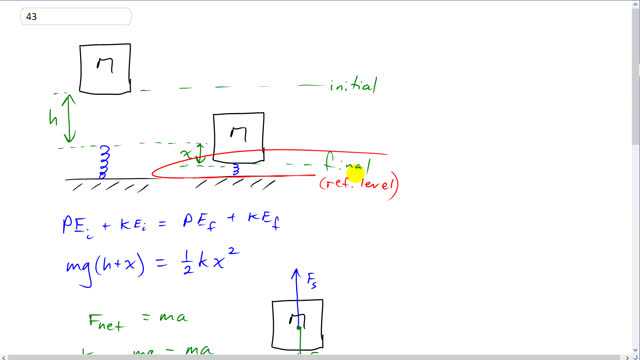
An engineer is designing a spring to be placed at the bottom of an elevator shaft. If the elevator cable breaks when the elevator is at a height above the top of the spring, calculate the value that the spring constant should have so that passengers undergo an acceleration of no more than 5.0 g when brought to rest. Let be the total mass of the elevator and passengers.

In order to watch this solution you need to have a subscription.
This is Giancoli Answers with Mr. Dychko. The elevator starts at this initial position, some height h above the uncompressed spring, and then it falls to this final position where the spring is fully compressed and it's compressed some distance x below the uncompressed position. We'll take this final place where the spring is fully compressed as the reference level for calculating gravitational potential energy. And so, we'll say the total initial plus kinetic has to equal the total final kinetic plus potential. And there's no kinetic energy in either case so that gets rid of those terms. And for the initial case, we have potential energy entirely due to gravitational potential energy and that's gonna be mg times the height above the reference level, which is gonna be h plus x because we are taking this final position to be the reference level. In the final case, there's no potential energy due to gravity, it's all elastic potential energy equal to one-half k times the compression of the spring squared because we have taken the reference level to be this position of full compression that means there is no height above the reference level here so there's no gravitational potential at this position. And that's a formula with with two unknowns in it; we don't know h, or sorry, we don't know x and we don't know k. And so we need another equation in order to solve it. When you have two unknowns and you have two equations, so well you turn to this constraint on the acceleration that's possible here. And looking at this free-body diagram for the elevator when the spring is fully compressed, we have a spring force upwards and gravity down and this net force equals ma due to Newton's second law. And the up force is gonna be the spring force due to Hooke's law is gonna be spring constant times the spring compression x, kx and then that's positive because it's going upwards, and then downwards, we have the weight, which is mg so minus mg because it's down and all that equals ma. And then we have kx equals ma plus mg where I have substituted 5g, in place of the acceleration because we are told that the maximum acceleration should be 5g. And collect these two together to make 6g, mg. So, we have kx equals 6mg and we can solve for x by dividing both sides by k and we have x is 6mg over k. So, we can substitute for x now in this formula, and get rid of one of our variables because we have x now in terms of k and we like to have k there because k is what we are ultimately solving for. So, I have rewritten this equation with x replaced by 6mg over k and it's just a whole bunch of algebra from here because we have mg times h plus 6mg over k equals one-half k times 6mg over k all squared. So, let's square this bracket and then we get 36 m squared g squared and this k is still there divided by 2k and there's a squared k on the bottom. And, on the left side, it didn't do anything. And then divide both sides by mg. So, one of the m's cancels and one of the g's cancels so that's mg to the power of 1 now. k over k squared leaves one k on the bottom. 36 over 2 is 18 and multiply everything by k here. So, we have kh plus 6mg equals 18mg. Subtract 6mg from both sides, you get 12mg and then divide both sides by h and you get k is 12mg over h. So that should be the spring constant - 12 times the mass of the elevator and occupants times acceleration due to gravity divided by the height above the uncompressed spring.
if the elevator is falling, wouldn't H be negative?
Hi suriyak786, thanks for the question. Yes, since we haven't specified the coordinate system, it's true that up is the positive direction, and down is negative. The elevator would have a negative velocity while it's falling. However, it's initial displacement is positive since we've done one unconventional thing here: the origin (in other words the location where the vertical position is zero) is not where the elevator starts. Instead we've chosen the origin, also called the reference level when talking about vertical position, to be at the height of the fully compressed spring, which is below where the elevator starts. This choice of reference level simplified our algebra a bit. is the displacement of the elevator compared to the reference level, and it is positive since it's above the reference level, and we have the conventional coordinate system with up being positive.
All the best,
Mr. Dychko